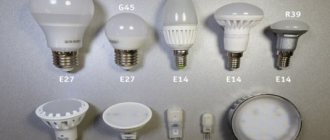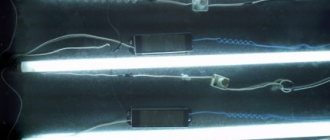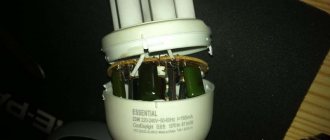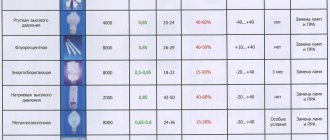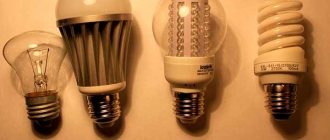Who was the first in the world to think and invent it and when?
Since ancient times, people have been looking for ways to illuminate at night. For example, analogues of the kerosene lamp were used in Ancient Egypt and the Mediterranean. To do this, a cotton wick was inserted into special clay vessels and olive oil was poured.
Residents of the Caspian Sea coast used a similar device, only instead of oil they poured oil into the vessel. In the Middle Ages, clay lamps were replaced by candles made of beeswax and lard.
But at all times, scientists and inventors have been looking for an opportunity to create a durable and safe lighting device.
After humanity learned about electricity, research reached a qualitatively new level.
For the invention of the first electric lamps suitable for commercial use, we have three scientists from different countries to thank. Independently of each other, they carried out their experiments and eventually achieved a result that turned the world upside down.
IMPORTANT! In the 70s of the 19th century, three patents were received for the latest devices - carbon incandescent lamps in vacuum flasks.
In 1874, the outstanding scientist Alexander Nikolaevich Lodygin patented his incandescent lamp in Russia.
In 1878 Joseph Wilson Swan applied for a British patent.
In 1879, inventor Thomas Edison received an American patent.
It was Edison who created the first industrial company to produce incandescent lamps. The big credit is that he was able to achieve a long runtime of over 1,200 hours thanks to the use of carbonized bamboo fiber.
In the early 80s of the 19th century, Edison and Swan organized a joint company in Britain. It was called “Edison and Swan”. At that time it became the largest manufacturer of electric lamps.
In the 90s, Alexander Lodygin moved to America, where he proposed using a tungsten or molybdenum spiral. This was another technological breakthrough. Lodygin sold his patent to General Electric, which began producing electric lamps with tungsten filament.
And already in 1920, one of the company’s employees, William David Coolidge, told the world how tungsten filament could be produced on an industrial scale. That same year, another General Electric scientist named Irving Langmuir proposed filling a light bulb with an inert gas.
This is what significantly increased the operating period of the incandescent lamp, and also increased the light output.
Humanity still uses these devices to this day.
Predecessors of lamps
Even in ancient times, people made attempts to make devices that would provide light at night. The first known "light bulbs" used for lighting were powered by fat. For this purpose, any vegetable oil or animal fat was used. Fat was poured into a clay vessel, a cloth wick was dipped into it, and it was set on fire.
Later, people began to extract oil, and then the kerosene lamp replaced the “candle in a container.” Then the first candles based on beeswax and pork fat appeared. However, all of the light sources described above had drawbacks, so scientists worked on inventing safer and more durable devices.
This is interesting! The first safe lamp, which was widely used for lighting, appeared around the second half of the 19th century. It was during this period that a large number of discoveries occurred that were closely related to the development of electricity.
The history of the light bulb
Of course, the history of the creation of the lamp is inseparable from the development of such a science as electrical engineering. It dates back to the discovery of electric current in the 18th century. This discovery contributed to the fact that outstanding scientists from all over the world began to study and develop electrical engineering, which by that time had become an independent science.
- The 19th century became the century of global discoveries. In 1800, the galvanic cell, a chemical source of current, was invented. It is also called the voltaic column in honor of the Italian scientist Alessandro Volta.
- The following year, in St. Petersburg, the management of the St. Petersburg Medical and Chemical Academy purchased an electric battery. This powerful device was purchased for the office of Professor Vasily Petrov. The battery consisted of 420 pairs of galvanic cells. For a whole year, Professor Petrov conducted experiments with it, until in 1908 he discovered the famous electric arc. It is a discharge that occurs between carbon electrode rods separated at a certain distance. It was then that it was proposed to use an electric arc as a light source.
- The first step towards the creation of modern incandescent lamps was the invention in 1809 of the first lamp with a platinum spiral at the base. This was done by the Englishman Delarue.
- A few decades later, in 1854, the German scientist Heinrich Goebel created a similar device. The main difference was that he used charred bamboo thread placed in a vacuum vessel. That is, this option was already much closer to the electric lamp known to us all. Goebel continued to improve his invention for another five years, creating a device that is called the first practical lamp. Unfortunately, he could not obtain a patent, because he was an emigrant without money or connections. However, he used his invention to illuminate the watch shop he owned.
- As for mass electric lighting, our compatriot, the outstanding scientist Pavel Nikolaevich Yablochkov, made an undoubted contribution. He began his experiments in Russia and then continued in Paris after emigrating. It was he who created a simple, inexpensive and durable “electric candle”. In 1876, the scientist presented his invention at an exhibition in London. In the same year, lamps created by Yablochkov began to appear first on the most visited streets of Paris, and then spread throughout the world.
ON A NOTE! A distinctive feature of the “Yablochkov candle” was that it did not require a vacuum. The filament, made of kaolin, did not burn out and did not lose its properties in the open air.
And, of course, speaking about the history of electrical engineering, one cannot help but recall the scientists who turned the world upside down - Alexander Lodygin and Thomas Edison. It was they who, conducting experiments independently of each other, created an electric lamp in the 70s of the 19th century.
Stages of development
If you are still interested in who invented the incandescent lamp, then pay attention to the chronology, which is presented in the table:
| Date in years | Incandescent light bulb development event |
| 1803 | Petrov from Russia produced a voltaic arc using a powerful battery. |
| 1808 | G. Davy (England) also used an arc discharge for lighting, but not for long. |
| 1838 | Jobard from Belgium invented a lamp that was equipped with carbon rods. |
| 1840 | The English astronomer Delarue presented his invention in the form of a lamp with platinum conductors. |
| 1841 | Thanks to the efforts of F. Moleyn from England, devices with platinum rods and carbon filler appeared. |
| 1845 | King replaced the platinum conductors with carbon electrodes. |
| 1854 | G. Gebel invented the prototype of a modern light bulb with a filament made of charred bamboo. |
| 1860 | D. Swan (England) presented a light bulb using carbon paper as conductors. |
| 1874 | A. Lodygin received the right to a lighting device with carbon electrodes. |
| 1875 | Didrikhson began optimizing Lodygin's light bulb. |
| 1875 – 1876 | P. Yablochkov invented the kaolin light bulb. |
| 1878 | D. Swan patented a device with a carbon thread. |
| 1879 | T. Edison received the rights to a lamp with platinum electrodes. |
| 1890 | Lodygin patented a device with a molybdenum and tungsten spiral. |
| 1904 | Sh. Yust, F. Hanaman secured the rights to a light bulb with a tungsten spiral (similar to Lodygin’s light bulb). |
| 1906 | W. Coolidge proposed producing light bulbs with tungsten conductors in the form of a zigzag, double or triple helix. |
As you can see, the history of the development of a filament lamp is long; inventors from different countries participated in its creation.
Gerard Delarue and Heinrich Goebel
In 1840, an astronomer from England, J. Delarue, invented a design that consisted of a vacuum tube and a platinum spiral inside it. His discovery became the world's first light bulb with a filament in the shape of a spiral. The device emitted a bright glow and could be used at almost any temperature. However, its cost was high and its service life was short, so it was not popular.
In 1854, G. Gebel designed the first prototype of an incandescent lamp. This is a device with a vacuum flask and an incandescent element made of charred bamboo. Perfume bottles were used instead of flasks. The vacuum environment was created by adding and pouring out mercury. This device was fragile, short-lived, but more practical than its predecessors.
Russian scientist Alexander Lodygin
In the second half of the 18th century, the famous scientist A. Lodygin invented and patented a filament light source with carbon electrodes. Tungsten or molybdenum spirals were used as a heating element. To extend the life of the light bulb, the inventor proposed pumping out the air from it, then the conductors would oxidize more slowly. These lighting elements immediately began to be used to illuminate streets and buildings in Russia.
This is interesting! The first light bulbs that were sold in America were manufactured according to A. Lodygin’s patent. In addition, the scientist invented coal lighting devices, the bulb of which is filled with nitrogen.
A little later, Lodygin’s light bulb was improved by V. Didrikhson, who installed several sequentially burning filaments in the flask.
Alexander Lodygin - inventor from Russia
In 1872, in St. Petersburg, Alexander Nikolaevich Lodygin began experiments on electric lighting.
His first lamps were a thin stick of coal sandwiched between three-dimensional copper rods. All this was in a closed glass ball.
This was still an imperfect device, however, they began to be actively used to illuminate buildings and streets of St. Petersburg.
In 1875, in partnership with Cohn, an improved electric lamp was produced. In it, the coals were replaced automatically, in addition, they were located in a vacuum. This development belongs to electrical engineer Vasily Fedorovich Ditrikhson.
In 1876, another researcher, Bulygin, also made adjustments. In its development, the ember moved forward as it burned.
At the end of the 70s, the incandescent lamp created by Lodygin and patented in Russia, France, Great Britain, Austria and Belgium finally came to the USA. Lieutenant Khotinsky went to the coast of America to receive ships built for the Russian fleet. It was Khotinsky who visited the laboratory and showed the “Lodygin lamp” and the “Yablochkov candle” to the American researcher Thomas Edison.
It is not known for certain how this influenced Edison’s train of thought, who himself was working on the creation of artificial lighting at that time. Be that as it may, it was Edison who brought the design of the incandescent lamp to a qualitatively new level, and also popularized it by organizing mass production. This helped to significantly reduce the cost, making it possible for even the poor to buy a lamp.
Alexander Lodygin also did not stop in his zeal to improve the incandescent lamp. After moving to the USA, in 1890, Lodygin received another patent - for a lamp with a metal filament made of refractory metals - octium, iridium, rhodium, molybdenum and tungsten. This was a real breakthrough in the field of electrical engineering. The invention was a resounding success, and in 1906 the patent for it was purchased by General Electric. By the way, this company belonged to Thomas Edison.
Her appearance
The very first - experimental - light bulb was an elongated tube, inside of which there were platinum strips, to which current was supplied. The design did not change much later: the threads twisted in a spiral, the tube took on the shape of a pear.
You might be interested in Description and types of lamps
For comparison: Lodygin’s lamp was made in the form of a thin coal stick, which was clamped with copper rods. All this was placed in a round glass ball.
Lodygin's lamp was unlike modern ones
Edison's lamp was a flask from which the air was pumped out. A thin coal rod was burning. However, the inventor did not stop at one light bulb: thanks to his improvements (the invention of a screw base, socket, fuses, switches, etc.), the operating time of the lamps increased.
Edison's creation of the light bulb
It is generally accepted throughout the world that the electric light bulb was invented by the scientist Thomas Alva Edison.
Over the years, Edison experimented in the field of electrical engineering. For almost two years he searched for the perfect filament.
The researcher conducted experiments with more than six thousand carbon-containing materials. Methodically sorting and examining various substances, Edison came to the conclusion that the best option was Japanese bamboo, from which the fan case was created.
In 1879, the first newspaper article appeared announcing the invention of an incandescent lamp with a carbon rod by Thomas Edison. It was called “Edisonian Light”. Such a lamp could burn continuously for forty hours. That same year, Edison patented his invention.
It cannot be said that Edison made significant changes to the incandescent lamp created by Lodygin.
Incandescent lamp: prototypes
The invention of the incandescent light bulb is credited to several scientists. Some of them worked at the same time, but in different countries. Scientists who worked at a later time made significant improvements to the inventions of their predecessors. Thus, creating an incandescent lamp is the work of several people.
Direct development of designs with incandescent elements began in the 30s of the 19th century. The Belgian scientist Jobard introduced the world to the first carbon-core design. His coal lamp was not widely used only because it burned for no more than 30 minutes. However, this was progress at the time.
Why is everyone talking about Thomas Edison's light bulb?
As we can see, Edison's role in the invention of the incandescent lamp was intermediate, but this does not detract from the value of his contribution. Thomas Edison's light bulb was “born” thanks to thousands of experiments and many hours of hard work. It was Edison who was able to achieve the best result at that time in terms of lamp emission time, and was also able to connect together a lamp, an electric generator, a plug and a socket, and invent a rotary household switch.
Today, this undoubtedly great invention of mankind is used less and less. Incandescent lamps are giving way to more economical and efficient LED lamps, which can last as long as lamps and even have similar bases - for example, E27.
First attempts
It is difficult to say exactly who came up with the idea to create a light bulb. But before Edison's light bulb appeared, hundreds of experiments were carried out and many similar inventions were announced. Arc bulbs appear first, and then incandescent bulbs. In the 19th century, the discovery of the voltaic arc phenomenon led inventors to the idea of creating artificial light. This required connecting two connected wires to electricity and then moving them slightly apart. This is how a glow appeared between the wires.
There is information that the Belgian Gerard was the first to create a lamp with a carbon rod. Current was applied to the device and the rod produced light. Later it became known about the Englishman Delarue, who replaced coal with a platinum thread.
Such light bulbs were considered valuable discoveries, but their application was accompanied by great difficulties. Platinum filament was an expensive pleasure; not everyone could afford to use such a lamp. The carbon rod was much cheaper, but it was not enough for a long time.



